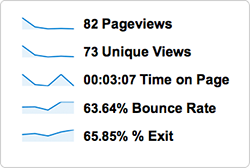Google Analytics: An Inbound Marketing Must-Have
I always find in interesting to hear people's reaction when I tell them we can track how many people visit pages on our website. I shouldn't say, "we can track," because it's Google that does the tracking. Google knows everything and learning from their analytics is key to a successful inbound marketing strategy.
Google Analytics is a feature we can add to any website to track just about everything you'd want to know about site visitors — how many, where they come from, where they go, how long they stay, what they click on, and on, and on. It truly is remarkable what we can learn from these statistics and how important they are to optimizing inbound marketing efforts.
 I thought it'd be fun to take a quick look at the analytics for my video blog from last week and explain a little about it's performance over the past seven days.
I thought it'd be fun to take a quick look at the analytics for my video blog from last week and explain a little about it's performance over the past seven days.
Pageviews
This one is pretty straight forward: it shows me how many times the page has been viewed. It could mean the same person visited 82 times, or 82 different people visited once.
Unique Pageviews
This number is a little more telling, because it takes into account anybody who has visited the page more than once and just counts it as one view. In my case, 73 different people have viewed the page.
Time on Page
Again, this is pretty self explanatory. This is the average amount of time visitors stay on the page. This number is important because it tells us if people are engaging with the content, or just leaving after a few seconds. In my case, I can figure that most people aren't watching the video, because the video itself is seven minutes in length.
Bounce Rate
Bounce rate is the percentage of visitors that land on a page (from Google, let's say) and then leave from that same page, without visiting any other pages on the site. A high bounce rate usually indicates that the content is not applicable to what the user was searching for.
Exit Rate
Exit rate is the percentage of visitors to your page that then leave the website. The difference between this and bounce rate is that these visitors may have been to other pages on the site before leaving from this page. According to these stats, it seems one out of three visitors clicked to some other part of the site from my blog, which is a good thing!
In Conclusion
These statistics are just the tip of the iceberg when it comes to the breadth of Google Analytics. It is really an amazing tool that will help you completely understand your website and optimize each and every page for better performance.
I personally love to look at the analytics because it shows me that there are actually people out there consuming the content I create. It drives me to not only continue to blog, but to create better content that attracts more and more people. Analytics can be a motivator to keep at it, which I think is an unspoken necessity of inbound marketing. Keep at it.
MONTHLY MARKETING INSIGHTS.
Get thought-provoking and actionable insights to improve how your firm makes a connection with your customers.





LEAVE A COMMENT